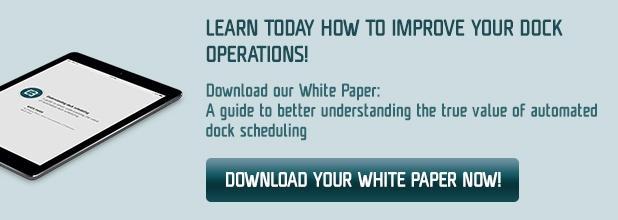6 Sujets phares de la chaîne d'approvisionnement pour 2016

Is it possible, you may ask, to identify only 6 supply chain hot topics for 2016? Supply chain is such a broad topic, covering so many industries and territories that we will attempt to give it some focus. We hope our readership will understand by now that our perspective, due to the dock scheduling and yard management solutions we offer, is one where we see both the challenges in the trucking industry and those at the facilities’ docks. Therefore our pick for 2016 are issues that affect our customers (e.g., manufacturing, distribution, retail, grocery) and the trucking industry that serves them. One client recently used the simile that a yard is like lungs, they breathe in and out goods. So let’s take a look at what can adversely affect a yard from breathing properly.
-
Drivers shortage - any changes ahead for the transportation industry
-
Is it time for you to become a shipper of choice ?
-
Chain of Responsibility; what is being done in North America, Australia and Europe.
-
How to increase productivity with mobile technology in yard management and dock scheduling
-
The growing importance of SaaS in the supply chain.- should we talk about Internet security?
-
Internet of things. Will this be the medium through which visibility and collaboration will flourish?
Driver Shortage
The driver shortage issue was broadly covered in the media for the past few years and all signs lead us to believe the issue is not going away. Demographics simply don’t change that quickly. In 2016, we’ll continue to follow this issue because, while solving the root cause of this problem is out of facility managers’ control, there are things that can be done by each operation that will improve the situation. Reducing unload times by insisting on palletized product and eliminating driver wait times through formal dock schedules are a few examples of solutions that can be implemented. Driver shortage is a problem that risks increasing your logistics cost and affecting your service levels. As we explained in our blog ‘Driver Shortage – Running on Empty’, this doesn’t mean a facility must play victim to these demographic and structural changes in the trucking industry. Countering the impact of this change in the transportation industry has been the cornerstone of an international effort to make facilities more efficient; a term now accepted as becoming a Shipper of Choice.
Shipper of Choice
 Unlike the driver shortage issue, becoming a Shipper of Choice is something that is within each facility’s control. Similar to any continuous improvement initiative, these are targeted efforts that facilities can address that provide direct benefits (i.e., reduced driver detention charges, faster turn-around times, reduced carrier rates, etc.) and indirect improvements (i.e., improved customer and supply chain relationships, better flow of goods, reduced stress levels at the docks, etc.). In our first blog on this topic ‘Carrier Review – On the Road to Becoming a Shipper of Choice’, we provided tips on how to establish the process, set objectives, and how to collaborate with your supply chain partners. Furthermore, and respecting the fact that each facility (e.g., distribution versus manufacturing, fresh produce versus consumer goods, collect versus prepaid) has different challenges, we wrote a second blog ‘3 Key Tips to Becoming a Shipper of Choice’ that emphasizes the need to adapt your strategy according to your business profile.
Unlike the driver shortage issue, becoming a Shipper of Choice is something that is within each facility’s control. Similar to any continuous improvement initiative, these are targeted efforts that facilities can address that provide direct benefits (i.e., reduced driver detention charges, faster turn-around times, reduced carrier rates, etc.) and indirect improvements (i.e., improved customer and supply chain relationships, better flow of goods, reduced stress levels at the docks, etc.). In our first blog on this topic ‘Carrier Review – On the Road to Becoming a Shipper of Choice’, we provided tips on how to establish the process, set objectives, and how to collaborate with your supply chain partners. Furthermore, and respecting the fact that each facility (e.g., distribution versus manufacturing, fresh produce versus consumer goods, collect versus prepaid) has different challenges, we wrote a second blog ‘3 Key Tips to Becoming a Shipper of Choice’ that emphasizes the need to adapt your strategy according to your business profile.
For a more extensive reading on how to become a shipper of choice, we invite you to download our white paper: ‘Stay in the Driver’s Seat by Becoming a Shipper of Choice’.
Chain of Responsibility
As everyone in the supply chain continues to strive for efficiencies, it is of growing importance to recognize the interdependencies of all the supply chain participants, be they shippers, consignees or carriers. When it comes to driver and road safety, regulatory bodies around the world have taken note of this. Without diminishing drivers’ responsibility relative to safety, governments (i.e., United States, Canada , Australia, Western Europe) have already introduced to varying degrees legislation that extend the responsibility to anyone who incites a driver to break the law. We will continue to monitor in 2016 what is referred to Chain of Responsibility (CoR) legislation. Executive officer, employer, prime contractor, operator, freight forwarder, agent/broker, scheduler, shipper, consignee, loading manager, loader and unloader, take note – under the Chain of Responsibility, you are all potentially accountable for driver offences as you all now have a role to play in ensuring compliance with safety regulations.
To get more insights on the concept of Chain of Responsibility and how it can affect your business, we invite you to download our white paper: ‘Understanding Chain of Responsibility in the Supply Chain’.
Mobile Technology and the Supply Chain
As previously announced, we released in 2015 a comprehensive group of mobile applications – C3 Warehouse (execution screen for our web based dock scheduling system), C3 Shunter (yard driver app) and C3 Dock (dock control screen for our SaaS Yard Management System). For 2016, we will continue to improve our mobile app offering. For starters, the three apps aforementioned are now grouped under one app - C3 Hub. Later in the year, we’ll be releasing our first version of the driver app; allowing carriers a unique visibility relative to the appointments they are delivering or picking up. It may be obvious to most why mobile is now so important but is worth reminding that, over and above the practicality of simply being mobile, applications can leverage the strengths of the some 10 sensors embedded in smartphones and tablets, including location, temperature, and camera. The adoption of mobile technology is bringing new functionality that was previously unimaginable or at the very least, expensive to deploy and to maintain. Furthermore, this provides companies a window of connectivity to the Internet of Things, potentially unleashing greater collaboration, visibility and efficiencies with your supply chain partners and customers.
SaaS Supply Chain Management Systems
 Although the growing acceptance of Software-as-a-Service (SaaS) is no longer debated, we feel it important to continue to talk about the advantages, including Internet security. As explained in a 2015 blog ‘5 Big Benefits of Cloud-Based Supply Chain Management Systems’, SaaS applications definitely will continue to influence the modern supply chain. In 2016 we expect Internet security to take an increasingly important part of media attention, and justifiably so. However, Internet security is not confined to SaaS applications; it is a concern for both in-house infrastructure and cloud-based systems. The fear that IT managers express regarding security and SaaS applications is primarily due to the sense that the security mechanisms are then out of their control. It doesn’t mean their own servers are safer, whether it be from external threats or internal theft. The question about security is therefore about managing risk since no solution can guarantee to be 100% secure.
Although the growing acceptance of Software-as-a-Service (SaaS) is no longer debated, we feel it important to continue to talk about the advantages, including Internet security. As explained in a 2015 blog ‘5 Big Benefits of Cloud-Based Supply Chain Management Systems’, SaaS applications definitely will continue to influence the modern supply chain. In 2016 we expect Internet security to take an increasingly important part of media attention, and justifiably so. However, Internet security is not confined to SaaS applications; it is a concern for both in-house infrastructure and cloud-based systems. The fear that IT managers express regarding security and SaaS applications is primarily due to the sense that the security mechanisms are then out of their control. It doesn’t mean their own servers are safer, whether it be from external threats or internal theft. The question about security is therefore about managing risk since no solution can guarantee to be 100% secure.
Therefore, in supply chain systems, companies will weigh the benefits of the best-in-class solution, its capital and maintenance costs and finally, the security risk. We will expand on this topic during the course of the year, but it is our experience, as a provider of both licensed software and SaaS solutions, that our clients win using SaaS on all three fronts.
The Internet of Things
The incessant thirst for visibility in the supply chain will encourage experts in transportation, warehousing, manufacturing and retail to find innovative ways to exchange information. Much like individual consumers take advantage of the GPS map application on their smartphone to obtain traffic information based on everyone’s relative position and speed in traffic, the Internet of Things (IoT) may provide endless possibilities in supply chain logistics.
IoT is often linked with big data, but that doesn’t mean you’ll be using your mobile phone to tap into a large data center. Take, for example, www.marinetraffic.com. They are able to capture the GPS data from each ship (cargo, tankers, fishing, pleasure crafts, etc.) from around the world and illustrate it in a simple public website. This is another example of taking simple, singular pieces of data and amassing them to create big data. Then they turn around and make available their data through APIs. This means that other organisations (possibly port authorities and locks) can tap into their ‘’big data’’ and create new automated systems that respond to their specific requirements. I believe this is an incredible example of how one can create value by simply organizing existing data and opening up their APIs for others to create additional innovative applications.
If you have examples like marinetraffic.com, specifically pertaining to supply chain logistics, please share with us in the the comment section below. There certainly is no lack of big data in supply chain logistics. It is now up to innovative, collaborative solutions that are based on the concept of IoT to unleash its power for everyone’s benefit.
To get more information on how The Internet of Things will impact the modern supply chain, we invite you to download our white paper: The Internet of Things and the Modern Supply Chain.
In conclusion, I wish to remind readers that the New Year has just started and it is therefore appropriate to examine your operations and ask yourself how these six topics could affect your business.
-
Is the driver shortage issue going to affect my transportation costs?
-
Am I on the road to becoming a shipper of choice and thereby sustaining the growth of my bottom line?
-
Am I collaborating with drivers to ensure that they respect safety regulations?
-
Am I leveraging mobile technology on my docks, gate, yard in order to reduce equipment costs and improve worker productivity?
-
Is it time to look at agile and collaborative SaaS systems to replace rigid on-premise systems?
-
Internet of things - relative to supply chain visibility, what piece of data would make a breakthrough improvement to your operations?
The C3 Team,


